1. Overview and research design
1.1 Introduction
This text consists of a summary of the entire thesis, presenting its aims and research questions, and discussing the choice of method and the design of the project. Furthermore, I develop a number of fundamental, theoretical points of departure. These parts inform the reading of the three main sections of the thesis, the studies V1-V3. The conclusions that follow draw largely on the results of three studies and thereby assume that the reader already has knowledge of them.
1.1.1 Background
Historical performance practice went through a major 'ideological' shift towards the end of the 20th century. This new spirit was manifested as a decisive turn towards 'musicking', performativity, and an embodied approach to historical information (Small, 1998; Butt, 2002). Such tendencies are also reflected in my performing and teaching activities. My artistic practice generates invaluable material for my research.
Although my practice is primarily situated in the early music environment, the design of my research project transcends the frame of studies in historical performance, by adopting a perspective based on embodied music cognition (Jensenius, 2007; Leman, 2008).
The research project brings my artistic and pedagogical practices together, and comprises my work with some of the leading Scandinavian baroque orchestras (Concerto Copenhagen, Camerata Øresund, Finnish Baroque Orchestra etc.) as well as workshops and concerts with my students at the Malmö Academy of Music and the Royal Danish Academy of Music. I am also regularly invited as a so-called ‘baroque expert’ to direct modern orchestras when they perform baroque programs (Tallin Chamber Orchestra, Ostrobothnian Chamber Orchestra), and thus my artistic practice is not strictly limited to the early music environment.
As a baroque violinist, I use an historical instrument and employ playing techniques based on historical performance practice. Apart from the obvious difference in sound between the modern and baroque violin, there is another distinction that is more relevant to the present study: the specific kinaesthetic affordances of the baroque instrument (Boyden, 1990; Gibson, 1986). The baroque violin is held without a shoulder rest and chinrest, which makes the violin grip freer and more flexible in comparison to that of the modern instrument (Tarling, 2000). This allows for greater freedom in body movement, and it might have some implications on the role of the body in the interpretation and performance of baroque music.
When I started to play baroque violin back in Bratislava in the late 1980s, I accepted the awkwardness of the playing technique as relevant information in itself. The instrument, being authentic, was to dictate all aspects of phrasing, articulation, dynamics, and, most importantly, the sound. The way the instrument 'decided to sound' was accepted as historical information.
In this respect, my baroque beginnings were all about finding a sound which is different from the traditional aesthetics that I had grown up with. The instrument was the main source, and the awkward 'chin-off' technique (i.e. without fixing the instrument under the chin) became the crucial means of achieving this sought-for difference. Looking back from the perspective of today, the kinaesthetic advantage of freeing the body from a fixed grip that is afforded in the baroque violin, was simply neglected.
Only later, like my childhood beginnings with the modern violin, did my finding of the sound trigger the curiosity of what is behind the sound, leading to a discovery of movement, dance, and poetry. First, I attempted to renounce temporarily my habitus as a modern violinist, assuming that I was constructing a new one, that of an HIP performer. After a period in a vacuum, accumulating and rigorously applying historical information, my baroque violin playing became more and more idiomatic. Historical performance practice was no longer the final goal, but a means to a new end: an embodied musical interpretation.
I use the term 'idiomatic' in the broad sense of embodying the instrument. The baroque violin became an integrated element of my lived experience, as the basis for a meaningful integration of historical information into communicative performance. Not only did my Slovak folk music background, and my clumsy attempts at jazz and rock play a crucial role in constructing my kinaesthetic vocabulary of violin playing, but so also did my embodied skills of sports (football).
Having intuitively established expressive body movement as a central tool for interpretation, claiming to assimilate dancers and singers into my playing, I realized that many assumptions lay behind my claims. How exactly do I embody a mimetic action? How do I assimilate a dance step?
Additionally, in my practice as a performer, I found a great deal of confusion concerning body movements in the musical negotiations of a rehearsal, even in the ensembles that employ expressive movements as a core method of interaction and coordination. But when they talk, it is often about sound. The shape of a gesture is translated as a crescendo leading to an accent. Dance step-units become articulations and phrasing. Poetic images are expressed through sound colours. But why do we so seldom talk about how it moves?
I became increasingly concerned with this question. To look at the musical notation; to mentally imagine how the music sounds; and to then realize this sonic image as an actual sound. I started to call a violinist who applies this strategy a 'Soundist'. Obviously, a Soundist will also talk about gestures, dance, and body movements. Even a Soundist must move to produce a sound. And the intention to produce an expressive sound will trigger expressive sound producing movements, that can be visually perceived as expressive in themselves.
And yet, I wondered how the reverse process would work; devising the movements first, directly from the score, with various external inspiration sources, and letting the sound happen as a result of these movements. This intriguing strategy I started to call a 'Gesturist' approach to musical interpretation. Obviously, a Gesturist will have to make sound, in order to make the performance intelligible.
Through workshops with dancers, singers, and actors I have attempted to acquire a kinaesthetic vocabulary and a different understanding of music as performed, grounded in its material qualities, and experienced through a musician’s body. All these qualities I have attempted to apply to violin playing. The workshops made me aware of the inherent physicality of mimetic action, dance and poetic imagery. In the three studies V1-3, which constitute the main parts of this thesis, I attempted to capture and assimilate the physical aspect of these experiences into performative interpretation.
Rather than representing gestures and dance through sonic imitation on the violin, I have attempted to embody the centripetal and centrifugal forces palpable in mimetic action and dance. Here, the movement patterns generate a dynamic physical field of impulse and repose. The activation of the body–floor relationship creates a kinaesthetic context in which the sound producing bow action is situated. The resulting sound is thus imbued with gestural quality.
1.1.2 Soundist (vs.) Gesturist
This thesis is built on an exploration of Gesturist and Soundist strategies for the creation of performative interpretations of baroque music.
Section V1, 'Mimetic action', is set in typical Gesturist territory, exploring physical gestures that are drawn from an embodied experience in the natural environment. Here, Mark Johnson’s image schemata provide a tool for the direct translation of the narrative implied in Telemann’s score into the body movements of a violinist.
A Gesturist will also consider dance forms as a natural source of inspiration for a violinist’s body movements. I approached the Rebel study V2 'Dance' with the enthusiasm of a Gesturist, but soon realized the technical challenges that the dance forms pose for an uninitiated dancer-violinist. After an intense period of dance lessons and workshops I deemed myself fluent enough to translate the impressions from dance directly into my playing. Yet again, Johnson’s image schemata served as a tool to reduce the complex stylistic and technical features of dance into basic experiential qualities of weight, direction, speed, force, and shape.
In Section V3, Vivaldi’s Four Seasons, I devise a gestural vocabulary which draws on the poetic imagery implied in the musical score and the Sonnets accompanying the score. If dancing felt like a foreign element explored in a familiar territory, in the Vivaldi study I found myself far outside of the Gesturist comfort zone. The well-known Four Seasons concertos are technically demanding, and not seldom performed by famous virtuosos for a mere display of technique. In this study, I took the challenge of Soundist virtuosity seriously. If my ambition did not amount to an application for Soundist citizenship, I at least hoped for a legal residence permit to acquire fluency in Soundist virtuosity.
The residency turned out to be a success, albeit it only a temporary one. Returning home to a Gesturist strategy, I could utilise the technical aspects of sound production and the efficiency of bowing, but it was not until I approached the poetic aspects of the score through expressive body movements that my interpretation fell into place in performance.
1.2 Aims and Research Questions
Musical perception is multi-modal (Godøy & Leman, 2010) and a musician’s interactions with an instrument and scores, as well as with fellow musicians, are codified in a vast gestural repertoire (Davidson, 2002). Instrumental virtuosity, as well as the mastery of beautiful sound and musical shaping, is determined by the accurate and effective execution of body movements (Galamian, 1962). If we understand music as movement (Jensenius, 2007), and recognize that baroque music is based on mimetic gestures, dance, and poetry (Matter, 1987; Tarling, 2005), then it may be conceivable that a performance interpretation of a baroque score can be drawn from the details of embodied knowledge of a musician. Therefore, the aim of my project is to explore body movement as
a) a factor in the interaction with the instrument
b) a factor in the interpretation of a composition
Two research questions can further define these aims:
How can the body movement of a violinist inform a performative interpretation?
Can the qualities of mimetic gesture, dance, and poetry be assimilated into baroque violin bowing through an embodied interpretation of a musical score?
1.3 Method
Analysis of the video documentation of my individual practise, rehearsals, and concert performances is the core method of this thesis (for a further discussion of video analysis, see Section 1.3.4). I participate in most of the video examples, as a director (from the violin), concertmaster, and teacher. Since the object of my research is my own artistic practice, my method involves an oscillation between a first and third person perspective (Leman, 2010) in the analysis of the video documentation. I also discuss my triple agency in this project – researcher, performer, and observer – in section 1.3.1 below.
1.3.1 Insider and outsider perspectives of artistic practice
Studies of music-related movements are often based on a combination of observation and qualitative analysis on the one hand, and analysis of quantitative data on the other. Through the distancing factors in these methods, an outsider perspective is a factor in the construction of knowledge.
On the other hand, studies by participant performers bring the lens of examination straight into the middle of the action, evoking normativity, subjectivity, and tacit knowledge – often referred to as 'insider knowledge'.
“Participant-observation” serves as shorthand for a continuous tacking between the “inside” and “outside” of events; on the one hand grasping the sense of specific occurrences and gestures empathetically, on the other stepping back to situate these meanings in the wider contexts. (Clifford 1983, p. 34)
Observers attempt to organise the richness of the collected data through qualitative and quantitative methods and arrive at a conclusion through deduction. Participants describe the phenomena they experience and through induction attempt to situate and conceptualise their findings within a bigger picture (Peshkin, 1988).
Prior to this PhD project, I would assess my playing from a two-dimensional perspective. In practicing, action-feedback loops directed my steps through auditory perception (Vaggione 2001, Coessens & Östersjö, 2014). After a concert, auditory memories, snapshots of moments from the performance would play back in my head for many hours as involuntarily reflective processes, assessing my own performance.
When I entered the doctoral studies programme, the two-dimensional model seemed to acquire a new quality, as if there was a new 'station' on the simple feedback loop. A new agency, a new dimension, built upon a new awareness of 'I' as a performer when playing, and further moulded by the attempt to articulate the background evaluation of the 'I' as an observer. At times it was difficult to discern which role I was taking on. It could be the observer in me picking up the violin, and the performer sitting down to listen. And then 'we' felt there was someone else, who made this dynamic conversation possible, the new 'I' as an artist-researcher.
Marc Leman (2010) discusses three different perspectives in gesture studies. The first-person perspective of the performer-researcher is ‘based on self-observation and interpretation of experiences’ (Leman, 2010, p. 127); the third-person perspective of an observer is ‘based on the measurement of body parts and sonic forms’ (ibid, 127); and the second-person perspective ‘is based on how gestures function as social cues’ (ibid, 127). The second person perspective, such as suggested by Leman, has a strong bearing on the function of gesture within a group of musicians, such as the ensembles and orchestras with which I am interacting in the studies discussed in this thesis.
Leman proposes a solution to the dangers of both the assumed objectivity of the observer and the uncritical subjectivity of the performer, suggesting that ‘the study of musical gesture can be grounded in an empirical methodology that combines these three different perspectives’ (Leman, 2010, p. 127).
The dialogical approach of the second-person perspective of the researcher can engage the first- and third-person perspectives in a discourse. These other two agents may materialise as participant and observer, but this dialogue also extends to my conceptual play with a Gesturist-Soundist dichotomy. In addition to my double role as participant and observer, I take turns participating and observing both as a Gesturist and a Soundist.
As a participant who forgets and an observer who assumes, I can use qualitative analysis of video in my role as a researcher to create a platform where my assumptions trigger my memory as participant. Hereby, my subjective experiences of participation are further guided, structured and articulated through observation and analysis, while the third-person perspective in the observations is guided by my understanding of the process as an insider.
In other words, the insider (me as a performer) gets a view from a distance (me as an observer), and the process of conceptualization (me as a researcher) results in a unique access to the experiential knowledge of a performer. The below image could therefore be read either as a depiction of a two-part relation – the two-folded subjective experience of the artist-researcher, who can adopt a third person perspective as an observer – or as a three-dimensional representation of my project, in which I can engage in observation, analysis, and performance.
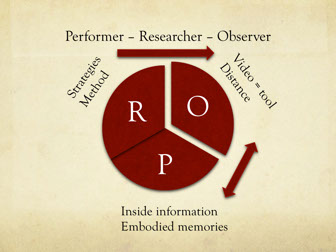
Performer - Researcher - Observer
1.3.2 Preparatory workshops with dancers, singers, and actors
The initial workshops with dancers, singers, and actors were designed to define possible platforms of interdisciplinary interaction, and to build tools and terminology for further enquiry.
One of the first projects I recorded on video was a performance of Monteverdi’s Vespers with Concerto Copenhagen and the Ars Nova Copenhagen choir.
I set up the camera to capture the singers and violins in the live performance. This particular view, with a violinist standing on a podium behind a singer, allowed for a detailed analysis of the relation between the pronunciation of the text in comparison with the bowing action
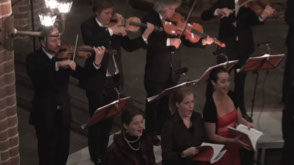
Ex. 1 Monteverdi’s Vespers with Concerto Copenhagen, 2010.
At the opera performances (Stefani Niobe) in the Boston Early Music Festival, I set up the camera in a similar way. Positioned in the orchestra pit, I could capture the singer on stage just above me in the same frame. In this way I was going to map the bowing action as an imitation of text declaimed in a more dramatic setting.
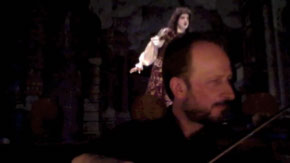
Ex. 2 At the Boston Early Music Festival, studying gestures, 2011.
Also in Boston, I used the same setup for a comparative study with dancers. The camera captured my bow in the context of the dancers’ moving bodies. The main objective of my observations was to analyse how my bowing related to the movement of the dancers in the performance.
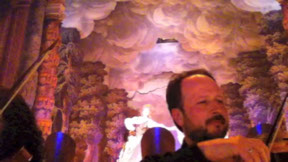
Ex. 3 At the Boston Early Music Festival, observing dance, 2011.
Although the first round of analysis revealed a connection between the bowing action and the steps of a dancer, or the text declaimed by a singer, the connection seemed superficial. On a phenomenological level, the similarities were limited to surface appearances. I needed to explore the movement and speech assimilation at a more basic physical level, rather than based only on visual and articular cues.
Text, action, and dance all pointed to a common denominator, hidden under the surface appearances. This was the stage at which I recognized a crucial perspective connecting the actor, dancer, and singer with the violinist: body movement, which would become the explicatory factor in all my continued work on this thesis.
1.3.3 Case studies and categories of a violinist’s movement
This thesis explores three main categories of a violinist’s body movement based on gestural patterns derived from dance and acting. These categories mirror the interdisciplinary context of my enquiry.
The category of 'Gesture' in Section V1 is concerned with the assimilation of physical action into sound-producing movements. Telemann’s Don Quichotte Suite affords a rich variety of gestures and movements for my experiments. The sound-producing movements and expressive gestures merge to 'tell a story' or express a physical action.
In Section V2 'Dance', the French dance suite by Rebel, Les Caractères de la danse, presents the basic dance patterns which I attempt to assimilate in my body and my violin bowing. The project involves several orchestras, including Concerto Copenhagen, and dance workshops with baroque dance expert Deda Cristina Colonna.
Vivaldi’s Four Seasons concertos are truly technically demanding. Here, I can explore musical gestures through virtuoso violin playing, in the context of the poetic images of natural phenomena and animals, folk dances, hunting calls, and plaintive or drunken songs, all expressed in the accompanying Sonnets.
Two studies were launched within the PhD project which are not included in the thesis.
I made a study of a project which constitutes a further inquiry into the material in V1. Gulliver’s Travels, the on-going musical theatre performance for children, returns to the theme of acting. While the storytelling in Don Quichotte is restricted to the frame of a concert performance, Gulliver requires acting from the performers. Two violinists in pirate costumes tell their story (the true story!) of how they travelled with Gulliver. We visit and 'sonify' not only the famous sites from the novel, such as Lilliput and Brobdignag, but also places that were 'omitted' by Swift – Paris, Slovakia, and Istanbul. To keep the children’s attention, we have to keep a continuous and intensive narrative going even in the violin playing, shaping the talking and playing as a unified whole.
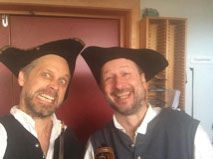
Ex. 4 Gulliver Travels with Bjarte Eike, 2013.
I also commissioned a solo violin piece from Kristin Thora Haraldsdottir which was intended to be premiered in the final concert, connected to the defence of this thesis. This collaborative project explores a compositional process drawn from my bodily gestures in interaction with my instrument. The aim was to challenge my method by exploring a gesture-based compositional method which is situated in a different aesthetic. How does my practice translate beyond the field of baroque music? I claim in V1 and V2 that a gesture-based approach to musical performance can allow me to transcend the framework of reconstructed performance practice through historical information. My embodied understanding of musical gestures in the score provides a different source in the process of interpretation-finding. But how does this method translate to a different musical aesthetic? However useful the initial working process was, the piece has not yet been completed, and I therefore do not discuss this composition in the thesis.
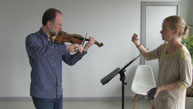 .
. 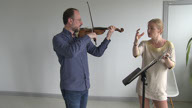
Ex. 5 Workshop with the composer Kristin Thora Haraldsdottir.
1.3.4 Video analysis
Sorting and organizing the video documentation was an initial challenge, as I had recorded all rehearsals and concerts from autumn 2010 until spring 2012. When my choice of case studies crystallised, I had a tremendous amount of video material waiting to be processed!
Already at this stage I therefore decided to base the organisation of material on an over-arching qualitative coding, which gave me thematic definitions related to a specific category of gesture, such as 'throwing-gesture', 'sword-attack', 'sigh-gesture', 'menuet-lift', 'languid movement', and so on. This kind of labelling influenced my conceptualization of these gestures as separate objects independent of their historical or compositional context.
Naturally, my analyses are subjective and personal, since they always draw on my artistic understanding of a specific performance situation. In order to validate the results, I therefore always display the full analytical procedure so that the viewer can make his or her own interpretation of the data.
A considerable number of ensembles and orchestras have been involved in the project (Concerto Copenhagen and other orchestras and ensembles in Denmark, Norway, Finland, and Iceland) which has allowed for a plurality of perspectives as well as a variety of material to compare. In every case study there are several ensembles participating in various situations of live music making.
In January 2014 I visited the studio in the Department of Musicology at Oslo University. With the help of Alexander Jensenius and two doctoral students I made my first motion capture project. I also applied the Musical Gestures Toolbox, designed by Alexander Jensenius, to some of my videos. The possibility of visualizing gestures through software technology enhanced my qualitative analyses with various visualisation features.
In the motion capture session, I played all of the initial phrases from my case studies, in three different modes. As I had done in my studio sessions, I started with a 'sonic version', where I restricted my bodily action (as much as I could) to sound production. Then in the 'gestural version' I used the normal amount of bodily movement to express the character of the dance (Rebel), or chosen action (Telemann). In the final 'conducting version' I imagined that the two assistants in the studio were my orchestra and I was conducting them, or trying to make them dance with me.
Motion capture felt like an intriguing method for acquiring accurate data to measure and highlight my bowing in relation to body movements, adding another level of quantitative data to my video examples.
At the same time, I was refining the qualitative analysis in the 'video essays', and through this work I began to achieve much more of the in-depth representations that I had been looking for. Hence, instead of building a new level of quantitative analysis, I decided to use materials from the motion capture in my qualitative gestural analysis.
The analysis of the video documentation is presented in the form of short thematic video essays, often with a threefold development:
Experiment – Application – Confrontation.
I start in my studio, building ideas for experiments. The ideas from the studio are applied within the various contexts of teaching, rehearsing, and concerts, in an experimental interaction with other musicians and students.
As well as experimenting with my ideas in projects as a director and teacher, every video essay comprises a 'confrontational' moment from projects where I am not a director. These situations bring new perspectives to the musical negotiations, where my persuasive arguments are not addressed to the orchestra, but to the authority of another director often with contrasting ideas. Many interesting exchanges of 'gestural' negotiations arose in the course of rehearsals, especially in the rare moments of disagreement.
The video essays have been edited in iMovie. Initially I was intending to use iMovie only temporarily and to change later to more powerful software (i.e. Adobe Premiere), but it turned out that for my purposes iMovie was the most efficient solution.
The first versions of the video essays were simple examples embedded in, and complementing my written text. While I found the examples very clear and to the point, the reaction from my colleagues and supervisors was to the contrary. They did not seem to see what I saw in the videos, and, without the reference of the video, the text itself did not make sense either. That became the impulse to bring the text and video together. There are now introductory texts to the sequences, subtitles for the spoken text, and there are 'thought bubbles' representing my thoughts in the various situations.
Some gestures needed to be highlighted. Rather than relying on the reader to recognize the importance of a given example on the first view, or, to choose to watch the video again, I decided to control the viewing and re-viewing of important passages myself by repeating some sequences in a loop.
The video essays became the impetus for the creation of a thesis in the form of a website, and here, the possibility of combining traditionally analytical texts with an analysis drawing on, and presented mainly through video, became the final solution for the structure of the thesis. It is my hope that this will allow the viewer direct access to the embodied knowledge that has been activated and expanded throughout the course of the project.